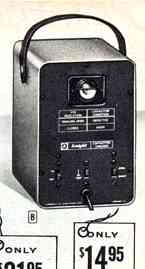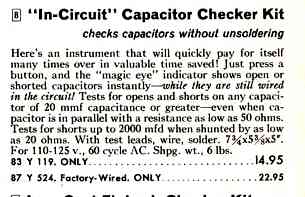- News & information
- About
- History
- George V. Voinovich
- George V. Voinovich Collection
- Calendar
- How to Find Us
- News
- Archives
- Photojournalism Fellowship Project
- Photo Essays
- Current Fellow
- Previous Fellows
- Reports and Publications
- Archives
- Students
- Prospective
- Center for Entrepreneurship
- Environmental Studies
- HTC/Voinovich School Scholars
- Master of Public Administration
- Current
- HTC/Voinovich School Scholars
- Center for Entrepreneurship
- Environmental Studies
- Master of Public Administration
- Alumni
- Contact
- School Leadership
- Strategic Partners Alliance
- Ohio University Public Affairs Advisory Committee
- Ohio University Public Affairs Advisory Committee
- Faculty and Fellows
- Faculty
- Visiting Professors
- Voinovich Fellows
- Professional Staff
Tube-era capacitor testers Part Three,
Knight, Sprague and Cornell-Dubilier "Open/ Short" testers
Tube-era capacitor "open/ short" testers
I've been asked several questions about this variety of cap testers including how useful they are in testing modern caps and how they work.
Of the ones pictured, the Sprague has a sticker on the back that reads "Patent Pending". Since other companies such as Knight and Cornell-Dubilier came out with similar testers, I am assuming Sprague did not get that patent.
What tubes are used in open/ short cap testers? The Sprague Kwik-Test KT-1 uses a pair of 1626 surplus triode tubes, one as rectifier and the other as oscillator. The eye tube is a surplus 1629. The Knight-kit pair each use a selenium rectifier, a 6C4 triode as oscillator and a 6E5 eye tube. The Cornell-Dubilier BF-90 "HandiCheck" (below) uses a 6W4 rectifier, a 6V6 as oscillator, and a 6E5 eye tube.
How do open/ short cap testers work? These testers can detect an open or shorted cap even if the cap is in parallel with a resistor as low as 50 ohms (open) or 20 ohms (short) according to the Knight-kit manual. The open test works with any cap that is 20 pF or more and the shorts test with any cap to 2000 MFD. An open cap typically has one of its leads disconnected from the foil inside and thus shows a capacitance of less than 20 pF.


Knight Cap Tester kit 83-Y-119 ad
Each of the testers has a hard-wired coaxial test lead that is about 40 inches long with clips on the end for connecting to a cap to be tested either directly or in the circuit of a device that is NOT powered.
The coax test lead length is critical and should not be made longer or shorter. The coax length is the key to how these testers check for "OPEN" caps. Each tester has an oscillator running at a frequency of about 20 MHz give or take a few MHz. The coax test lead and a component or two inside represent a quarter wave stub to the output of the 20 MHz oscillator. To a radio frequency, a quarter-wave stub with one end open (in this case at the clip end) represents a low-impedance short at the other end (the oscillator output). A cap of 20 pF or larger changes the apparent electrical length of the quarter wave stub. The eye tube closes as it detects a voltage (and no longer a radio frequency short) at the oscillator output.
The "short" test uses a current-limited 6 or 12 volts of AC filament voltage with the eye tube showing a current draw if the cap is shorted or in parallel with less than 20 ohms.
Usefulness of open/ short cap testers As noted in the earlier parts 1 and 2 of tube-era cap testers, leakage is the real problem with capacitors in the circuits of older tube equipment. The other tube-era capacitance testers covered previously can test for leakage at a typical cap operating voltage and can be used to reform long dormant electrolytics. While a short/ open cap tester can quickly determine whether an in-circuit cap is open or shorted, it is useless for testing leakage other than a hard short of 50 ohms or less. Since cap leakage even at several megohms can be critical in some circuits, an "open / short" cap tester has very limited usage since it cannot detect leakage even as low as a few hundred ohms and obviously not at a typical cap operating voltage.
Usefulness at present
I'm of the opinion that the best use of an open/ short cap tester is either as an interesting piece of classic test gear, as an example of the action of a quarter wave stub, or a parts donor
especially those with 6E5 eye tubes. One of the few uses for which I might try this type of tester is shorts on a variable cap provided that the cap is not directly in parallel with a tuned coil.
The Lafayette LC-4 combines both an open/ short cap tester (left side) and a bridge cap tester. A switch toggles between the two functions. It was reviewed in Cap Testers Part 2.
date 8-2-11
A Navy 6000-BAC morale receiver was the previous item on the bench.
Go back to the BA Pix Homepage.
Contact Information:
(740) 593–9381 | Building 21, The Ridges
Ohio University Contact Information:
Ohio University | Athens OH 45701 | 740.593.1000 ADA Compliance | © 2018 Ohio University . All rights reserved.
